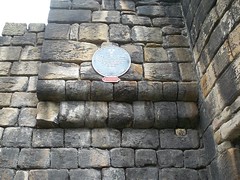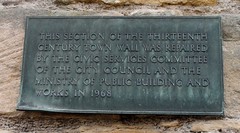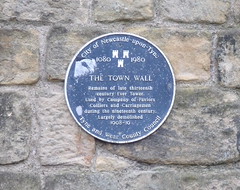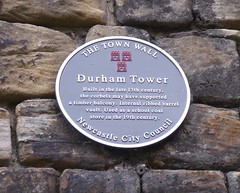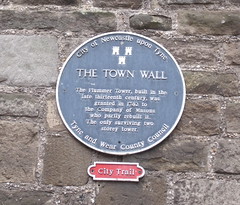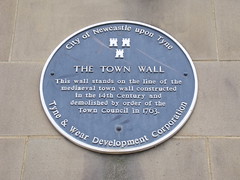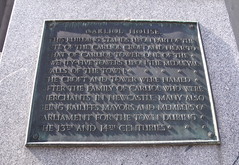Town Wall, Newcastle
Commemorated on 18 plaques
The Town Wall The thirteenth century New Gate, the largest gate on the wall, lay to the east of here. It became the gaol for the County of Newcastle in 1399 and was demolished in 1823.
St Andrew's Church, Newgate Street, Newcastle upon Tyne, United Kingdom where it sited
The Town Wall The Herber Tower, built in the late thirteenth century, was restored in 1770-1 by the Company of Armourers, Curriers and Feltmakers who used the tower for a meeting hall.
Friars Street, Newcastle upon Tyne, United Kingdom where it sited
The Town Wall Site of late 13th Century Gunner Tower Converted in 1821 for use by Company of Slaters and Tylers. Demolished 1885 Foundations excavated 1964
Pink Lane, Newcastle upon Tyne, United Kingdom where it sited
The Town Wall. The Durham Tower, built in the late 13th Century, is one of the seventeen wall towers.
Rear of Stowell Street, Chinatown, Newcastle upon Tyne, United Kingdom where it sited
This section of the thirteenth century town wall was repaired by the Civic Service Committee of the City Council and the Ministry of Public Building and Works in 1968.
Off Forth Street, Newcastle upon Tyne, United Kingdom where it sited
The Town Wall. Remains of late thirteenth century Ever Tower. Used by Company of Paviors Colliers and Carriagemen during the nineteenth century. Largely demolished 1908-10.
Stowell Street, Newcastle upon Tyne, United Kingdom where it sited
The Town Wall, Durham Tower. Built in the late 13th century, the corbels may have supported a timber balcony. Internal ribbed barrel vault. Used as a school coal store in the 19th century.
West Walls, Newcastle upon Tyne, United Kingdom where it sited
The Town Wall. In 1280 the Black Friars were granted the right to this postern through the wall to give them access to their gardens beyond.
Back lane of Stowell Street, Newcastle upon Tyne, United Kingdom where it sited
The Town Wall. In 1810 part of the wall was removed to allow access from Darn Crook to Gallowgate. The Andrew Tower, to the north of here, was lost when the churchyard was enlarged in 1818.
St Andrew's Church, Newgate Street, Newcastle upon Tyne, United Kingdom where it sited
The Town Wall. The Corner Tower: two turrets at right angles to one another. At this point, in the early 14th century, the wall was turned east to enclose the newly acquired suburb of Pandon.
City Road, Newcastle upon Tyne, United Kingdom where it sited
The Town Wall. The Plummer Tower, built in the late thirteenth century, was granted in 1742 to the Company of Masons who partly rebuilt it. The only surviving two storey tower.
Croft Street, Newcastle upon Tyne, United Kingdom where it sited
The Town Wall. This wall stands on the line of the mediaeval town wall constructed in the 14th Century and demolished by order of the Town Council in 1763.
Sandgate, Newcastle upon Tyne, United Kingdom where it sited
The Town Wall. The Sallyport or Wall Knoll Tower, a lesser gateway, was built in the early fourteenth century. The Company of Ships’ Carpenters rebuilt the upper storey in 1716 as a meeting hall.
Causey Bank, Tower Street, Newcastle upon Tyne, United Kingdom where it sited
The Town Wall. This stretch of wall was built in the early fourteenth century. From here the wall walk stepped down to the Close Gate at the foot of the slope and came to be known as the Breakneck Stairs.
Hanover Street, Newcastle upon Tyne, United Kingdom where it sited
The Town Wall. The Morden Tower, built in the late thirteenth century, was used by the Company of Glaziers, Plumbers, Pewterers and Painters from 1619. Partly rebuilt in 1700.
Back lane of Stowell Street, Newcastle upon Tyne, United Kingdom where it sited
Carliol House. This building stands upon part of the site of the Carliol Croft and near to that of Carliol Tower, one of the twenty-five towers upon the mediaeval walls of the town. The croft and tower were named after the family of Carliol who were merchants in Newcastle, many also being bailiffs, mayors and members of parliament for the town during the 13th and 14th centuries.
Market Street, Newcastle upon Tyne, United Kingdom where it sited
The Town Wall. Site of 14th Century Close Gate. Damaged during 1644 siege when Town Wall was breached, it was repaired in 1648. Used as a prison after 1771 it was demolished in 1797.
Close, Newcastle upon Tyne, United Kingdom where it sited




